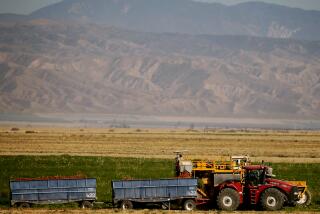PERSPECTIVE ON THE DROUGHT : Water for the People : Agriculture accounts for 85% of the usage, so inefficient farming, not householders, should bear the brunt of cuts.
- Share via
State lawmakers are about to decide how to allocate water during this fifth dry year of what may be a record drought. That politicians will make these decisions is unfortunate. Their inability to adopt an efficient solution means that everyone will be worse off.
Two questions need to be answered. First, who should get the water? Second, what compensation should be given to those who lose water rights?
Economists are virtually unanimous on the answer to the first question: A resource should go to the individual who values it most. In the case of water, this is without question the residential user. In many California districts, it costs about five cents each time a toilet is flushed. Most Californians are willing to pay that price for the five gallons of water necessary to maintain sanitary conditions in their households.
On the other hand, no rice grower could ever afford to pay a penny per gallon, as costs would then far exceed revenue. This means that rice growers in particular, and farmers in general, do not value the water as highly as household users do. If rice growers could sell their water at one cent per gallon to residential users, they would gladly forgo growing rice.
The second question is political. Should farmers be paid for the water taken from them, or should it simply be transferred without compensation? Fairness suggests that those who based their decisions on a cheap water policy should not be penalized when water prices change. Second, payment to farmers for their confiscated water would make them better off than they would be with the water. It would also make residential districts better off because individuals would have the highly valued water to use as they see fit. The price is negotiable, but it should be high enough to cover the farmers’ lost profits and low enough to avoid crippling residential water districts.
Some issues to keep in mind:
-- Residential users account for only about 8% of water usage in California. That means that even if every residential user were to cut back by 25%, the total usage for the state would fall by only 2%. Agriculture accounts for about 85% of state usage. Major cuts to residences would make up very little of the shortfall to agriculture.
-- The government, not farmers, is to blame for water-intensive agriculture in California. The mandated price that farmers pay for water is only a tiny fraction of that paid by residential users. If farmers were charged even double their current price, they would be induced to switch from water-intensive crops and irrigation technologies to water-saving ones. This would, in all but the most extreme circumstances, eliminate urban water conservation as an issue.
-- Urban water rationing is more than a mere inconvenience. It imposes real costs on the community. The damage to landscape and other property would amount to many millions of dollars each year. While residential gardens may seem less important than agriculture, money is actually saved by sacrificing some agriculture and maintaining residential gardens.
Water rights have historical precedent that is difficult to alter. For example, the Modesto and Turlock irrigation districts have senior water rights in the Tuolumne River over Bay Area residential users. The speed with which the snowpack melts affects the amount of water that San Francisco’s Hetch Hetchy reservoir receives. While there is a logic to this, it is hardly in the best public interest.
The water rights structure and district preparedness also determine residential water supply. After all, Los Angeles, which is drier than the Bay Area, has not had water rationing during years in which the Bay Area has imposed significant restrictions. Southern Californians wisely used some creative methods to evade restrictions on the resale of agriculture water in recent years. A better solution is to change the federal rules, allowing farmers to sell their water to residential users.
It is ironic that as all of Eastern Europe moves toward market solutions to avoid the inefficiencies of rationing, California water regulators seem to prefer a Soviet-style approach. Most of our water officials are trying to be fair. Unfortunately, they have coupled their notions of fairness with a lack of ingenuity. Reason rather than political expediency should prevail.
More to Read
Sign up for Essential California
The most important California stories and recommendations in your inbox every morning.
You may occasionally receive promotional content from the Los Angeles Times.













